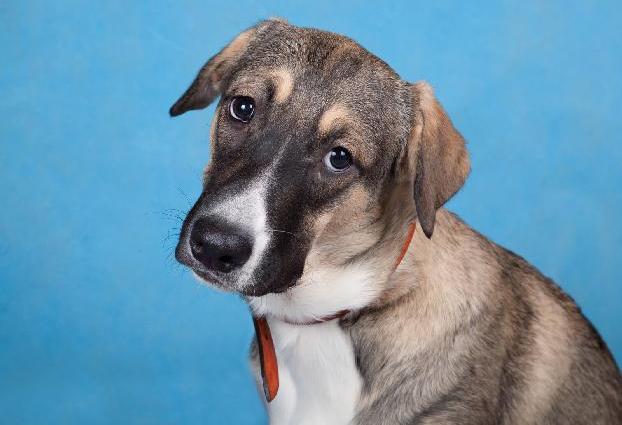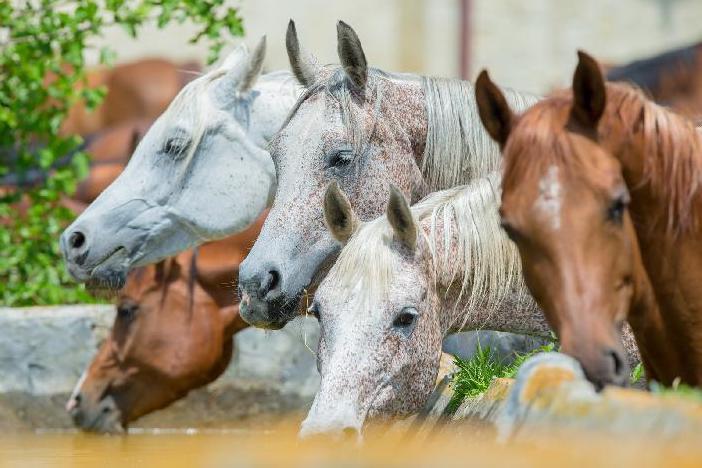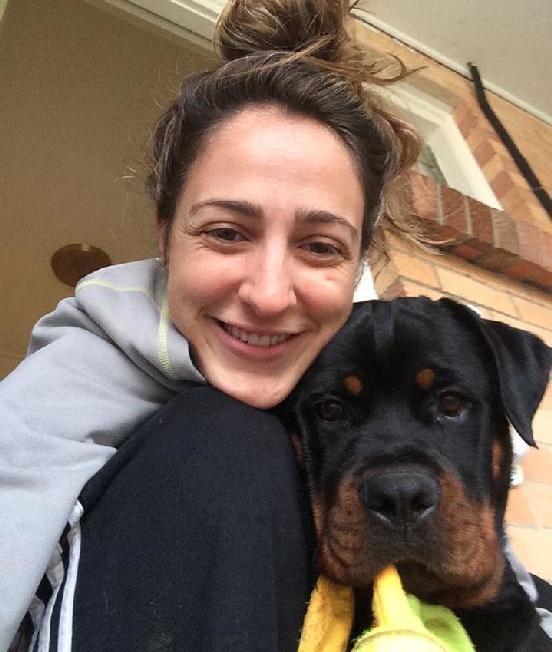
13 minute read
cats who keep their guardians awake at night
a v i a n Companion Bird Foster Programs – A Review
Sheila Blanchette explores the world of foster care for companion birds and the different programs currently available, and makes recommendations for how adoption and retention rates can be improved based on data she gathered from a number of multi-animal rescues over a period of six years
Advertisement
© Sheila Blanchette Star, a 7yearold Goffin cockatoo was surrendered due to plucking behavior. He spent several months in a behavioral foster home before being successfully adopted into his forever family
Within the New England area of the United States (i.e. Maine, New Hampshire, Vermont, Rhode Island, and Connecticut) there are many avian and multianimal rescues (private shelters) that have foster programs. These programs involve placing an animal in a temporary housing, outside of the rescue, for a duration of time to aid with illness, injury, stress, or caring for young offspring for a given duration of time. Depending on the rescue, companion birds may or may not be included in the foster program.
When a rescue does develop an avian foster program, there can be a variety of options:
Foster to Adopt Home: A companion bird is placed into an adoptive home for a “trial” period. A rescue or placement program may use this choice because the adopter has the knowledge and the proper environment for the companion bird. The rescue or placement program wants to make sure the companion bird can adapt to the new environment. After a designated time period, the adopter accepts the companion bird or the bird is returned back to the rescue.
Medical Foster Home: A companion bird has a medical issue and is placed into a temporary home. In this case, the foster family has experi
© Sheila Blanchette Josh, a 10yearold caique, was surrendered due to plucking and screaming. He was adopted and returned, and was then placed in an exotic bird sanctuary with another caique
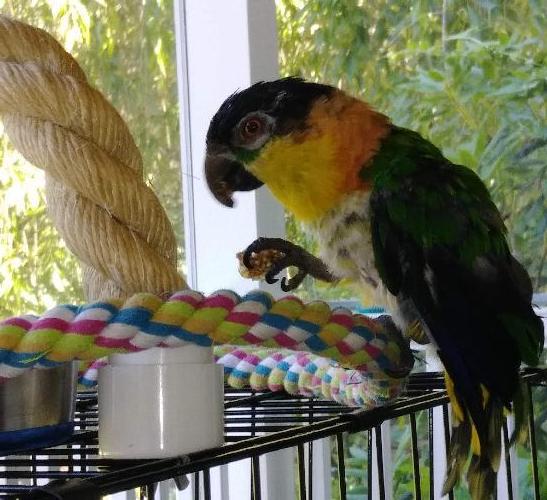
ence with helping with a specific medical issue. They may have a quarantine/quiet area and know how to properly administer medication. The foster family cares for the companion bird until the medical issue is under control or resolved. A rescue or placement program may use this choice so as not endanger other birds at the location. The rescue or placement program staff may not be able to give the oneonone attention which a foster home can give to a companion bird.
Temporary Foster Home: A companion bird is placed into a temporary home until a permanent home can be found. This usually occurs when a rescue or placement program may not have room at the location for the companion bird. They need a temporary space until there is room within the location. Avian placement programs may not have a permanent brickandmortar location, so they heavily rely on volunteers to be temporary foster homes. Additionally, some rescues and avian placement programs have included a subprogram as part of their community outreach called the safe haven option. This is used during domestic abuse or legal cases when a companion bird needs a temporary home as cases are being worked out (third party, safe haven) or when there is a loss of home, e.g. when a family loses their home due to financial reasons, weather damage, and/or fire.
Behavioral Foster Home: A companion bird has a behavior issue (screaming, plucking, and/or biting) and is placed into a temporary home to assist with behavior modification to increase the likelihood of adoption. A rescue or placement program may use this choice if they have volunteers who have experience helping with specific behavior issues.
Case Study: Intakes and Returns
I have volunteered at several local brickandmortar rescues (private shelters) in my area (north of Boston, Massachusetts) and have seen, over time, companion birds being returned because of the same behavioral issues. Adopters may say that a bird was “not trainable” or “would not bond” with them. Now, the rescue’s policy is to improve the welfare of the companion bird by getting him into a good and knowledgeable home. This strategy may reduce the undesired behavior. However, some rescues avoid placing birds in foster homes because, if returned, the upheaval of moving him from one home to another would cause him more stress, which could, in turn, cause an increase of the undesirable behavior.
In spite of this, I still saw birds being returned and then adopted back out with the same behavior issue. This did not happen a lot, but I began to wonder whether a foster program, related to behavior, could decrease the number of returned companion birds to multianimal rescues. I suggested starting a foster program that was focused more on behavior. One of the rescues asked me to obtain some data on the benefits of this plus possible outcomes of this, so they could consider updating their foster program.
Like any good researcher, I had a few analyst friends help me put together a simple survey. Amazingly, this mini case study started in 2013 and progressed through 2019. During that time, I received my IAABC parrot behavior consultant certification, and started the foster program at the multianimal rescue.
Data Analysis
In 2014, and again in 2018 as a followup, I surveyed brickandmortar local rescues in my area on their foster programs and outcomes related to companion birds. There were about 25 surveys sent out but, unfortunately, only nine rescues responded (even after friendly reminders). In any case, data is still data, and I found the following: In 2014, the number of intake birds was 1,386 (nine rescues): • Cockatiels and parakeets* were the largest number of intakes. • Additionally, from the survey, 78 birds were returned, 59% of which were parakeets and cockatiels (see Fig. 1, next page). *Parakeets includes budgies, ring necks, and any other birds that could be defined in the parakeet category.
In 2018, the followup survey was sent out to the same nine rescues and this time only seven responded. The data was as follows:
In 2018, the number of intake birds was 750 (seven rescues): • Cockatiels and parakeets (smaller)** were the largest number of intakes. • Additionally, from the survey, 42 birds were returned, again, 59% of which were parakeets and cockatiels (see Fig. 2, next page). **Survey improved with parakeet category
Reasons for Rehoming
The 2018 survey revealed that the reasoning for rehoming had not changed much from the 2014 survey: 1. Family/guardian can no longer care for the bird because: • Guardian passed away. • Guardian moved into an assisted living home. • Guardian has bequeathed bird to a new caretaker. • Guardian has lost home/job. 2. Undesired vocalization (noisy). 3. Aggression/biting/chasing. 4. Guardian has allergies (to bird).
Companion birds are most likely going to be rehomed at least once (maybe more) in their lifetimes. Though more surveying and feedback is needed, the more gathered information available, the better the assistance on improving and growing foster programs related to companion bird behavior could be.
5. Does not want the bird anymore because: • Too much work. • Moving. • Messy. • Kids in college. 6. Guardian’s life changes: • Pregnant. • Married. • New baby. • New significant other.
The next step after analyzing the data was to speak to the foster families to get supplementary information, data, and further details of outcomes. Of course, I had to ask the rescues for permission to contact the foster families. This was a more difficult part of the project. While collecting the data and progress reports, I also had to find out if the foster family and the rescue kept records on the assessment, training plans, tracking progress, and outcomes. Plus there was the need to follow up with the adopter of the companion bird.
The Case Study: Foster Program
The data also showed that, in 2014 and 2018, there were 24 companion birds in a foster program related to assisting with behavioral issues*. Out of the 24 birds, there were only three, Star, Josh and Jay, that met all the mini case study guidelines: o Behavior assessment. o Veterinary check (bloodwork) – no underlying medical issue. o Creating/updating training plan. o Some form of log tracking. o Transitioning plan to adopter. *Any birds that were adopted by the foster family were removed from the study.
Case Study: Star Star, a 7yearold Goffin cockatoo was surrendered due to plucking behavior. While at the rescue, he continued to pluck even with the introduction of foraging and enrichment toys. His veterinary examination and blood work were normal (no diseases) and there were no mites. He was DNA tested (male).
The rescue determined that Star was a good candidate for a behavioral foster home. The foster family had experience with cockatoos, and working with plucking issues. They slowly introduced very simple foraging toys, and incrementally increased the complexity.
After six months there was: o Documented reduction of plucking. o Improved Interaction with: o Advanced enrichment toys. o Increased activities outside the cage. o Small approximation training related to new activities. Transition Plan: o Documentation on process to introduce new toys. o Documentation on favorite food and treats for training. o Documentation of defined body language (what the bird looks like when uncomfortable or happy).
Star was adopted in November 2014 to adopters who had experience with cockatoos. They followed the transition plan and, when Star was comfortable with them, he went with them every day to the store they operated. Star loved hanging out at the store. The adopters also introduced him to new enrichment. In 2016, sadly, Star passed away. The adopter said he was happy and “so funny.”
Case Study: Josh Josh, a 10yearold caique, was surrendered due to plucking and screaming (undesired vocalization). While at the rescue, he continued to pluck even with the introduction of foraging and enrichment toys. His veterinary examination and blood work were normal (no diseases) and there were no mites. He was DNA tested (male).
The foster family had experience with mediumsized birds and plucking,
Figure 1: 2014 HOF Survey: # Companion Birds Intake as well as following a training plan on reducing vocalization. However, after five weeks of the vocalization increasing, they returned Josh to the rescue. He was then placed in an exotic bird sanctuary with another caique.
Case Study: Jay Jay, a 22yearold pionus was surrendered due to extreme behavior of attacking and biting. Jay’s story is very long and so is posted separately. Jay was my own foster bird and I kept detailed records on his progress. The following links detail his progression: Part 1 ‐ The Introduction Part 2 ‐ The First Training Lesson Part 3 – Capturing Behavior Lesson Part 4 – Transition Plan Lesson Part 5 – The Adoption and Beyond

Figure 2: 2018 HOF Survey: # Companion Birds Intake
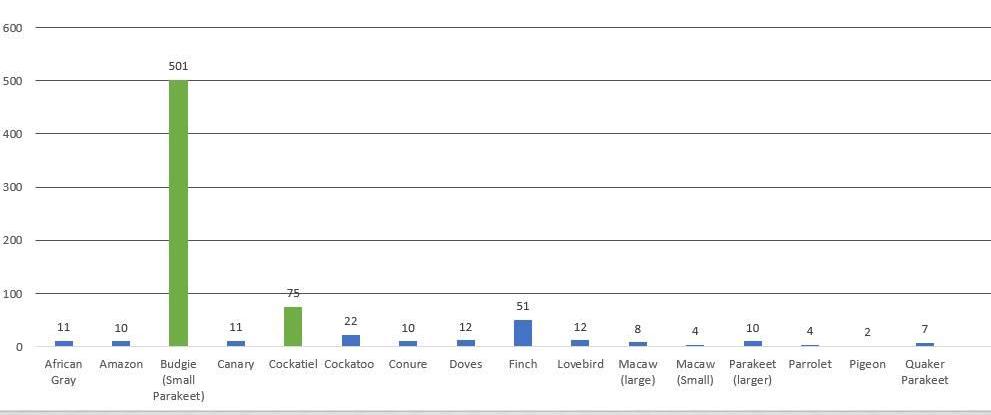
© Sheila Blanchette

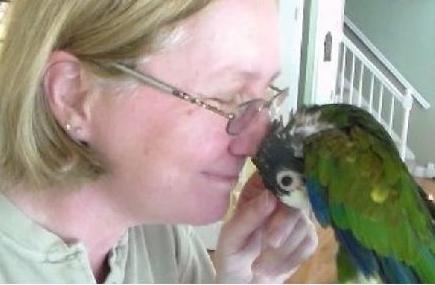
Author Sheila Blanchette (above) fostered Jay, a 22yearold pionus who was surrendered due to extreme attacking and biting behavior
This mini case study may not have produced a mound of data, but it was a good start to lay the groundwork for further study into behavioral foster programs for companion birds in multianimal rescues and others.
Summary of Findings
When foster homes were prepared and had accomplished a defined plan, and when the rescue/placement program, foster family, and adopter all worked together for the success of the bird, there was a reduced number of returned companion birds. When the adopter used the available resources and reached out to the rescue/placement program with any questions or concerns, the ensuing communication and assistance continued to keep the companion bird in the adopted home. The behavioral foster program was most successful when: • The foster home was experienced with a specific companion bird, understood the commitment and expectation, and had the appropriate environment and setup. • The foster home was properly educated for assisting with a specific behavior, including continuing education and access to the rescue trainers and staff members. • The foster home’s end goal of preparing the companion bird for adoption was defined, including adapting the bird to changes and the transition plan was ready.
Companion birds are most likely going to be rehomed at least once (maybe more) in their lifetimes. More surveying and feedback is needed. The more information gathered and available, the better we can improve and grow foster programs related to companion bird behavior. This could include a new trifecta support system (see Fig. 3, above) to assist multianimal rescues and others to reduce the number of companion birds returned and educating the public (community services).
My recommendations for this are as follows:
Rescues: • Have a contract or onsite certified parrot behavior consultant, trainer or staff member, who is trained in companion bird behavior analysis and can: o Review the intake paperwork and understand the behaviors (not rely on the labels). o Log behavior. o Determine if a foster home is needed and begin the evaluation and training plan. • Conduct companion bird education sessions for the public, foster homes, and potential adopters:
o An onsite certified parrot behavior consultant or trainer and/or other rescues could assist with sessions. Create online training sessions.
Foster Homes: • Have a staff member, certified parrot behavior consultant or trainer check in and adjust the plan with the foster home. The staff member, certified parrot behavior consultant or trainer works with the foster home in: o Reviewing the environment/setup. o Training in companion bird body language. o Formulating a detailed training plan (with explanations, and contingency plans). o Formulating a transition plan. o Providing support and assistance on expectations and planning.
Adopter Homes: • The staff member, certified parrot behavior consultant or trainer sets up: o Training in companion bird body language that adopters should attend. o A review of the training plan. • Access to education (can be prerecorded and posted online, e.g. YouTube, or in the form of webinars, or both). • Has support/assistance available from the rescue? By implementing this format, it would be my goal to promote a better understanding of companion bird behavior among adopters and fosterers. This would go a long way towards ensuring that behavior issues are successfully managed and addressed and that the birds’ speciesspecific needs are met, including mental, physical and environmental enrichment. Ultimately, this will help create stronger bonds between guardians and their avian charges, thereby keeping more birds in good homes. n

Resources
Blanchette, S. (2017). Case Study: A Foster Bird - The Past, The Preparation, and the Post Story: Part 1 - The Introduction [Video File] Blanchette, S. (2017). Case Study: A Foster Bird - The Past, The Preparation, and the Post Story: Part 2 - The First Training Lesson [Video File] Blanchette, S. (2017). Case Study: A Foster Bird - The Past, The Preparation, and the Post Story: Part 3 – Capturing Behavior Lesson [Video File] Blanchette, S. (2017). Case Study: A Foster Bird - The Past, The Preparation, and the Post Story: Part 4 – Transition Plan Lesson [Video File] Blanchette, S. (2017). Case Study: A Foster Bird - The Past, The Preparation, and the Post Story: Part 5 – The Adoption and Beyond [Video File]
Sheila Blanchette is an IAABC certified parrot behavior consultant/ trainer who has operated her own companion bird training company, Heart of Feathers Education & Training, in Haverhill, Massachusetts since 2015. She conducts in-home and online companion bird behavior consultations. Her love for birds began when she received her first red lory in 1995 and she joined the American Lory Society. She began volunteering at the Massachusetts Society for the Prevention of Cruelty to Animals and formulating her desire to improve the understanding and welfare of companion birds. She then began her study of avian behavior and applied behavior analysis and started reaching out to animal rescues in the New England to offer assistance with companion bird education and review companion bird cases. In 2017, she was named chair of the Quaker Parakeet Society Rehome and Placement Program, which includes coordinating the surrender and adoption of Quaker parakeets throughout the U.S., organizing and educating volunteers, and facilitating the foster program.


